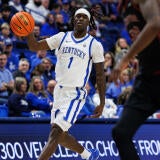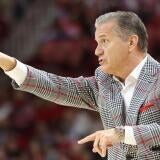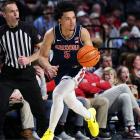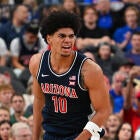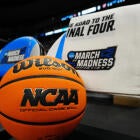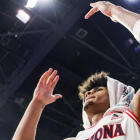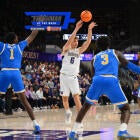NBA Draft 2022: Why more big men are returning for another year in college rather than turning pro
More centers like Kentucky's Oscar Tshiebwe and UNC's Armando Bacot are staying in school

In conversations with front office members over the past couple of months, I've asked a lot of questions about Chet Holmgren because he is the most fascinating and polarizing player in the 2022 NBA Draft.
Some would take him with the No. 1 overall pick. Others wouldn't use a top-three pick on him. One executive told me he sees Holmgren as a future Defensive Player of the Year. Another told me he's the type of player who will get played off the floor by teams that commit to a five-out small-ball attack.
They might both be right.
Which is among the reasons evaluating prospects who are centers and only centers has become the most challenging task executives face heading into each NBA Draft. Great centers are still great -- evidence being that the current MVP (Nikola Jokic) and current runner-up for MVP (Joel Embiid) are indeed both centers. But for every center who exceeds reasonable expectations relative to where he was picked, there are three or four guys labeled misses largely because they can't do things modern centers are asked to do.
Like guard in space.
"Getting cooked on defense is the biggest thing," said one former front office executive. "They put you in spread pick-and-roll and obliterate you."
This, by the way, is among the reasons why so many great bigs -- guys like Kentucky's Oscar Tshiebwe, North Carolina's Armando Bacot, Indiana's Trayce Jackson-Davis and Purdue's Zach Edey -- are returning to college next season when all of them might've been first-round picks as recently as 10 years ago. Sure, their ability to make notable amounts of money legally via name, image and likeness opportunities has proved to be a campus-magnet. But the truth is that those players were never picking between definitely playing in the NBA next season or definitely playing in college. They were mostly picking between maybe playing in the NBA next season or definitely playing in college, where they can likely make more money over the next year than they would've made as a professional.
"None of those guys you named were going to be first-round picks," said one evaluator. "Some of them wouldn't have even been second-round picks. Great college players sometimes don't fit in the NBA. We used to say that about small guards. Now we say it about traditional bigs."
Want more analysis of the 2022 NBA Draft? Listen below and subscribe to the Eye on College Basketball podcast where we take a deep dive on the top players heading to the next level.
The consensus assessment from scouts is this: unless you can guard in space at least a little on defense and either rim-run or stretch the floor on offense, you're probably not worth selecting too high in any draft.
So what to do with Holmgren?
Skeptics of the Gonzaga product's ability to actually become a star in the NBA point to the fact that he only plays one position and isn't obviously laterally gifted enough to awesomely guard in space -- although multiple evaluators said they believe he'll at least be "OK" at it. His slight frame is another clear area of concern. That's the bad. But the good is so good that his believers still see Holmgren as worthy of consideration to be selected first overall because they project him as an elite rim-protector and legitimate stretch-the-floor big who can play-make on the perimeter and reliably make 3-pointers. In other words, Holmgren is so gifted at some things that he really could someday be the Defensive Player of the Year and an annual All-Star but so questionable in other ways that he really could never become what top-two picks are supposed to become. And, yes, there is a scenario, given the way the game has evolved for centers, where he's both the Defensive Player of the Year and a defensive liability in certain situations because even three-time Defensive Player of the Year Rudy Gobert has proven to sometimes be a defensive liability in certain situations.
"Chet is one of the most unique prospects I've ever seen," said one evaluator. "If you take him No. 1, you might regret it. But if you pass on him, you might also regret it. ... I guess you can say that about lots of prospects. But I think it's more true with Chet than it is with most projected top-five picks."
Traditional vs. modern center
Once Holmgren comes off the board, who knows when the next center will be selected? It'll probably be Jalen Duren, the one-and-done physical specimen out of Memphis. But, and this is the problem for most bigs these days, he's more of a traditional center than a modern center in the sense that it's unclear how effective he'll ever be too far away from the basket on either end of the court. If Duren goes in the top 10, it'll be way closer to No. 10 than No. 1 despite him once being ranked No. 1 in his high school class.
He should've been born 20 years earlier.
Decades ago, Duren would've been an easy top-five pick while former Illinois star Kofi Cockburn would be in contention to go in the lottery. Now, Duren might not go in the top 10 and Cockburn, a traditional beast-mode center, is at risk of going unselected despite being a two-time All-American who destroys rims.
Why?
Because being a big who destroys rims is no longer as important as being a big who can move his feet and stay in front of smaller players in space, that's why. Consequently, tremendously productive and accomplished college products who once projected as special NBA prospects are now often unwanted at the next level.
That's great for the college game.
But don't get tricked into thinking bigs like Tshiebwe, Bacot, Jackson-Davis and Edey are all returning to college simply because of how much they love it -- or even for the NIL money that's available. That's part of it, sure. But those players are mostly returning to college because the NBA game has changed so much for centers that they're no longer desired the way they would've been in previous eras. Those players are mostly coming back because, with the sport's evolution, there really wasn't any great place for them to go.





